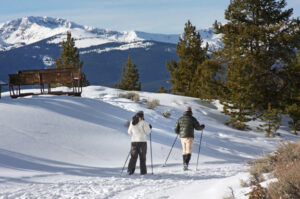By Mike Rosso
For this combined January/February issue, I thought we’d engage in a little wishful thinking.
As of this writing (Dec. 29), the Upper Arkansas River Basin is at 108 percent of average snowpack, the Gunnison Basin is at 90 percent and the Upper Rio Grande Basin is at 66 percent of average.
My smartphone tells me that Salida will see some snow on the last day of 2018, but my accu-window weather shows only traces of snow on the ground.
When I moved to Salida in 2001, I was aware of its designation as the “banana belt” of Colorado and the passing years have demonstrated much truth to that. A lot of the snow which falls in town can be swept away with a broom, although in early spring, I’ve had to break out the snow shovel on many occasions.
If we locals crave snow, it’s only a 20-minute drive up Monarch Pass to the Continental Divide, or up Cottonwood Pass to find plenty of the white stuff.
I have to confess, winter is not my favorite season – short days, cold nights, no greenery – but Central Colorado is a great place to be in winter; moderate temperatures, dryland hikes, skiing and showshoeing, blue sky days and plenty of hot springs spots for warming up the old bones.
But, my many years in Colorado have included some major snow events. I lived in Durango when a large spring storm dropped so much wet, heavy snow, that the former theater at Fort Lewis College collapsed under the weight. Fortunately, no one was in the building at the time so there were no injuries. I wasn’t here for the great May blizzard of 2000 in Salida, but did help a friend to clean up the aftermath, which took out many piñon tree branches on her property.
I’ve experienced some of the most frightening drives in early spring storms between Fairplay and Kenosha Pass, as well as on Monument Hill. I’ve also made the mistake of swapping out my snow tires in May, only to regret the decision before the month was out.
Also, I’ve done some pretty dumb things, like ski across an avalanche chute, unaware of the stupidity of such a move, or misjudged the time on a snow outing, having to return in the dark. Many of us have probably regretted not taking more clothing along on a winter outing, as well.
Of course, climate change throws the whole equation out the door. 2016 was the hottest year ever recorded on Earth, beating out the two previous years, which were also record-setting. 2018 saw one of Colorado’s least snowy winters on record. Colorado’s mountains receive nearly half of their annual precipitation in the form of snow, and projections show declining rates for the mid-twenty-first century. Less snowpack means less runoff, drought and increased chances for wildfires. Multiple independent measurements have indicated an overall warming of about 2°F across the southwest region in the past 30 years. NASA’s calculations suggested that the planet had warmed by well over a half-degree Fahrenheit from 2013 to 2016. We ignore the risks of climate change at our own peril, and it might already be too late.
In the meantime, for this “Snow” issue, we reached out to many of our regular contributors, asking them to conjure up some snow-related stories, and were not disappointed. We’re hoping we can help channel some big snow for 2019.
From stranded trains to tragic avalanches, and tips for enjoying the winter backcountry, I think we’ve covered a lot of ground … er, snow, for your winter reading pleasure. I hope you enjoy this issue. Maybe by the time you are reading this you’ll be sitting by a warm fire, watching big flakes falling outside your window.
We’ll see you again in March! –Mike Rosso


